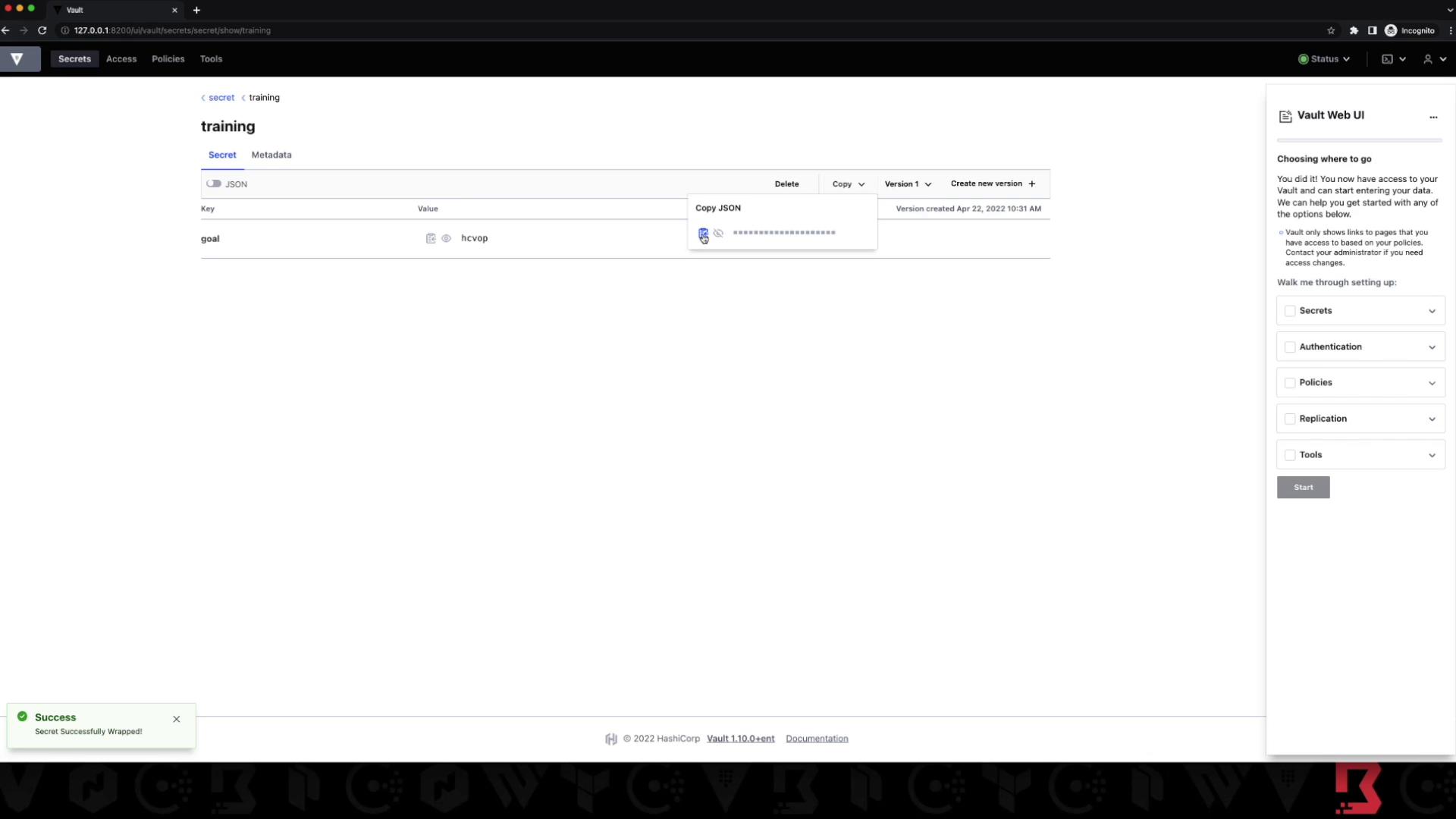HashiCorp Certified: Vault Operations Professional 2022
Create a working Vault server configuration given a scenario
Demo Cubbyhole Secrets Engine
In this tutorial, you’ll learn how to leverage Vault’s Cubbyhole Secrets Engine for per-token data isolation and use Response Wrapping for secure, one-time delivery of secrets. We’ll cover:
- Writing and reading token-specific cubbyhole data
- Proving isolation between tokens
- Populating and protecting a KV secret
- Generating and unwrapping a wrapped secret both via CLI and UI
Prerequisites
- Vault 1.10.0 Enterprise installed locally (initialized & unsealed)
- Environment variable:
VAULT_ADDR=http://127.0.0.1:8200 - Familiarity with basic Vault concepts (Vault Overview)
1. Verify Vault Status
vault status
Expected output:
Key Value
--- -----
Recovery Seal Type shamir
Initialized true
Sealed false
Version 1.10.0+ent
Storage Type raft
HA Enabled true
2. Authenticate as Root
vault login <root_token>
Success! You are now authenticated as the root user.
3. Create an Unprivileged Token
Create a token with only the default policy:
vault token create -policy=default
Output:
Key Value
--- -----
token hv.s.XXXXXXXXXXXXXX
token_accessor NuBg8k455X2yQERKgRxV3134
token_policies ["default"]
Save the token value and log in with it:
vault login hv.s.XXXXXXXXXXXXXX
Success! You are now authenticated with limited permissions.
4. Working with Cubbyhole
Every token receives a private cubbyhole path. Only the token owner can write/read its own cubbyhole.
4.1 Write to Cubbyhole
vault write cubbyhole/training certification=hcvop
4.2 Read from Cubbyhole
vault read cubbyhole/training
Key Value
--- -----
certification hcvop
4.3 Proving Token Isolation
Note
Cubbyhole paths are isolated per token. No token can access another token’s cubbyhole.
- Switch back to root
vault login <root_token> - Attempt to read the unprivileged token’s cubbyhole
Output:vault read cubbyhole/trainingNo value found at cubbyhole/training - Confirm unprivileged token can still read its own data
vault login hv.s.XXXXXXXXXXXXXX vault read cubbyhole/training
5. KV Secrets Engine & Access Control
Next, we’ll show how an unprivileged token is denied access to KV secrets written by root.
| Token Type | Accessible Path | Permissions |
|---|---|---|
| Root Token | secret/data/* | read, write, delete |
| Unprivileged Token | cubbyhole/* | read, write own only |
5.1 As Root: Write a KV Secret
vault kv put secret/training goal=hcvop
5.2 As Root: Read the KV Secret
vault kv get secret/training
====== Secret Path ======
secret/data/training
=== Data ===
Key Value
--- -----
goal hcvop
5.3 Denied Access for Unprivileged Token
vault login hv.s.XXXXXXXXXXXXXX
vault kv get secret/training
Error making API request.
Code: 403. Errors:
* permission denied on path "secret/data/training"
6. Response Wrapping
Response wrapping provides a one-time-use, time-limited wrapping token for secure secret transfer.
6.1 Generate a Wrapping Token
As root, request a 60-minute wrapped response:
vault kv get -wrap-ttl=60m secret/training
Key Value
--- -----
wrapping_token hvs.CAESIHHiPSBDnG75y4hN...
wrapping_token_ttl 1h
wrapping_token_creation_path secret/data/training
6.2 Inspect the Wrapping Token
vault token lookup hvs.CAESIHHiPSBDnG75y4hN...
Key Value
--- -----
path secret/data/training
policies [response-wrapping]
ttl 59m30s
num_uses 1
6.3 Unwrap as Unprivileged User
- Log in with the limited token:
vault login hv.s.XXXXXXXXXXXXXX - Unwrap the secret:
vault unwrap hvs.CAESIHHiPSBDnG75y4hN...Key Value --- ----- data map[goal:hcvop] metadata map[created_time:... version:1]
6.4 TTL & One-Time Use Demonstration
vault kv get -wrap-ttl=5s secret/training
# wrapping_token: hvs.CAESI…XYZ
# Wait >5 seconds
vault unwrap hvs.CAESI…XYZ
# Error: wrapping token is not valid or does not exist
Or with 5-minute TTL:
vault kv get -wrap-ttl=5m secret/training
# wrapping_token: hvs.CAESI…ABC
vault unwrap hvs.CAESI…ABC # succeeds
vault unwrap hvs.CAESI…ABC # fails immediately
7. UI Demonstration
In the Vault UI, a privileged user can:
- Navigate to Secrets → KV
- Select training and choose Wrap
- Copy the wrapping token and share via secure channels
An unprivileged user then goes to Tools → Unwrap Secret, pastes the token, and retrieves the secret.

Summary
- Stored token-specific data in Cubbyhole
- Verified strict isolation between tokens
- Secured KV secrets and demonstrated access denial
- Generated, inspected, and unwrapped response-wrapping tokens
- Showed one-time-use and TTL behaviors via CLI & UI
By following this guide, you can securely share secrets without exposing them directly over the network.
References
Watch Video
Watch video content
Practice Lab
Practice lab